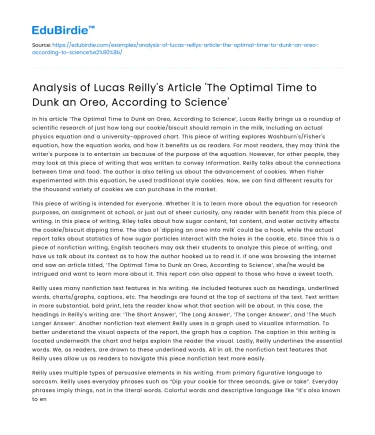In his article ‘The Optimal Time to Dunk an Oreo, According to Science’, Lucas Reilly brings us a roundup of scientific research of just how long our cookie/biscuit should remain in the milk, including an actual physics equation and a university-approved chart. This piece of writing explores Washburn's/Fisher's equation, how the equation works, and how it benefits us as readers. For most readers, they may think the writer's purpose is to entertain us because of the purpose of the equation. However, for other people, they may look at this piece of writing that was written to convey information. Reilly talks about the connections between time and food. The author is also telling us about the advancement of cookies. When Fisher experimented with this equation, he used traditional style cookies. Now, we can find different results for the thousand variety of cookies we can purchase in the market.
This piece of writing is intended for everyone. Whether it is to learn more about the equation for research purposes, an assignment at school, or just out of sheer curiosity, any reader with benefit from this piece of writing. In this piece of writing, Riley talks about how sugar content, fat content, and water activity effects the cookie/biscuit dipping time. The idea of 'dipping an oreo into milk' could be a hook, while the actual report talks about statistics of how sugar particles interact with the holes in the cookie, etc. Since this is a piece of nonfiction writing, English teachers may ask their students to analyze this piece of writing, and have us talk about its context as to how the author hooked us to read it. If one was browsing the Internet and saw an article titled, ‘The Optimal Time to Dunk an Oreo, According to Science’, she/he would be intrigued and want to learn more about it. This report can also appeal to those who have a sweet tooth.
Save your time!
We can take care of your essay
- Proper editing and formatting
- Free revision, title page, and bibliography
- Flexible prices and money-back guarantee
Reilly uses many nonfiction text features in his writing. He included features such as headings, underlined words, charts/graphs, captions, etc. The headings are found at the top of sections of the text. Text written in more substantial, bold print, lets the reader know what that section will be about. In this case, the headings in Reilly's writing are: ‘The Short Answer’, ‘The Long Answer’, ‘The Longer Answer’, and ‘The Much Longer Answer’. Another nonfiction text element Reilly uses is a graph used to visualize information. To better understand the visual aspects of the report, the graph has a caption. The caption in this writing is located underneath the chart and helps explain the reader the visual. Lastly, Reilly underlines the essential words. We, as readers, are drawn to these underlined words. All in all, the nonfiction text features that Reilly uses allow us as readers to navigate this piece nonfiction text more easily.
Reilly uses multiple types of persuasive elements in his writing. From primary figurative language to sarcasm. Reilly uses everyday phrases such as “Dip your cookie for three seconds, give or take”. Everyday phrases imply things, not in the literal words. Colorful words and descriptive language like “It's also known to enhance the flavor”. Colorful words such as 'enhance' produce a picture and induce emotions. Evidence positions the reader, adds weight to the author's point of view. Graphs and diagrams make the meaning of figures and statistics more readily accessible: look scientific and reliable.
The language style is deliberately chosen to influence the reader. For example, Reilly's essay's style creates an impression of research and authority that can impress the readers with knowledge, information, and the importance of the writer. Readers can distant from, or close to the writer depending on other techniques. Reilly did a great job considering the style in the context of the entire article. To add on, the order of points affects reader response. Dramatic beginnings are effective in engaging the reader, but the next challenge is to sustain reader interest. Reilly's use of personal pronouns allows readers to feel connected with the author. It makes us feel like we, the author, is talking to us.
Fortunately, Reilly effectively uses these elements in his writing to keep readers interested. Tactics such as a significant point, repetition, summing up, a conviction in tone, short sharp sentences can be used to persuade. In the body of the article, essential information, examples and strong opinions can be used to develop or reinforce viewpoints.
Everything that the writer says must fit together like links in a chain of pieces of a jigsaw puzzle to form a coherent argument or statement. When Reilly thought through and planned his writing, he organized various points in a sequence from the general to the particular. From the start to the conclusion of the report, each point builds on each previous point to form a persuasive argument.






 Stuck on your essay?
Stuck on your essay?

